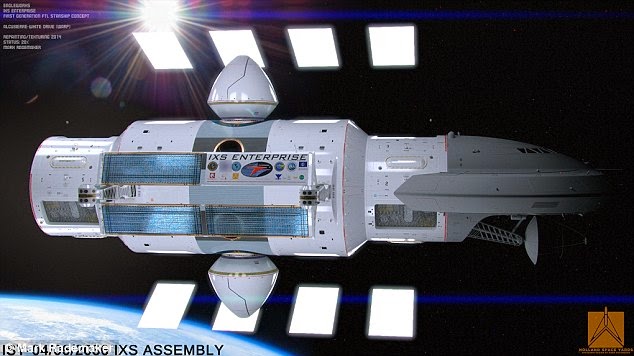- Nasa scientist in Houston worked with an artist to create the concept
- The interstellar spacecraft builds on previous designs that theoretically allow distant travel by bending space-time
- Called IXS Enterprise, it is similar to the Star Trek ship of the same name
- Dr White said the spacecraft could reach Alpha Centauri in two weeks
- Warp travel is the focus of Christopher Nolan's 2014 movie Interstellar
A Nasa scientist claims a mission into space isn’t
necessarily just something reserved for science fiction - and has revealed a
Star Trek-style ship that could make interstellar travel a reality.
Pictured above is an illustration of Dr White's IXS
Enterprise, an interstellar ship drawn by artist Mark Rademaker that could be
an accurate representation of what the first mission beyond the solar system
will look like.
The IXS Enterprise is a theory-fitting concept for a faster
than light (FTL) ship.
Dr Harold White is famous for suggesting that faster
than light (FTL) travel is possible.
The 100-year Starship Project is a joint endeavor
run by Darpa, Nasa, Icarus Interstellar and the Foundation for Enterprise
Development.
Announced in January 2012, the project has an
overall goal of achieving manned interstellar travel by 2112.
To do so it is evaluating a number of different
technologies, including ‘warping’ space time to travel great distances in short
time frames at faster-than-light speeds.
The project is also considering building ‘generation
ships’ that move slowly but have a self-sustainable long-term population.
To date Nasa has contributed $100,000 (£60,000) to
the project and Darpa $1 million (£600,000).
Using something known as an Alcubierre drive (above), named
after a Mexican theoretical physicist of the same name, Dr White said it is
possible to ‘bend’ space-time, and cover large distances almost instantly.
This, in essence, would allow a spaceship to travel
almost anywhere in a tiny fraction of the time it would take a conventional
spacecraft.
The ship in Nolan’s Interstellar movie, as well as
those in Star Trek, employ a warp engine.
And, in a series of new renders, Dr White reveals
how a real spacecraft dubbed the IXS Enterprise could do the same thing.
The images are based on the artist who created the
original look for the famous USS Enterprise ship from Star Trek - Matthew
Jeffries.
To make the latest renders Dr White employed the
help of artist Mark Rademaker and graphic designer Mike Okuda.
The ship has a number of features that make
interstellar travel possible. This includes the two rings surrounding the
central spacecraft - these are known as an Alcubierre drive and are used to
'warp' space-time and travel many light years in a matter of days.
The engine for Dr White's ISX Enterprise is based on
something known as the Alcubierre drive. As shown in the illustration above
this stretches space-time in a wave that causes the fabric of space-time ahead
to contract while expanding the space behind, theoretically allowing 'faster
than light' travel.
Although the speed of light is seen as an absolute,
Dr White was inspired by Miguel Alcubierre, who postulated a theory that
allowed for faster than light travel but without contradicting Einstein.
Alcubierre's theory was published in 1994 and
involved enormous amounts of energy being used to expand and contract space
itself - thereby generating a 'warp bubble' in which a spacecraft would travel.
Allowing space and time to act as the propellant by
pulling the craft through the bubble would be like stepping on an escalator.
Despite Dr Alcubierre stating his theory was simply
conjecture, Dr White thinks he and his team are edging towards making the realm
of warp speed attainable.
This illustration shows Dr White's design in its
entirety. Struts around the spacecraft show how it would be directly attached
to the rings. At the front is the 'bridge' where the crew would conduct
operations on the spacecraft. Towards the back is the cargo area where
so-called exotic matter for fuel would be stored.
According to Gizmodo, their engine could get to Alpha Centauri in two
weeks as measured by clocks on Earth.
The process of going to warp is also one that is
smooth, rather than using a massive amount of acceleration in a short amount of
time.
'When you turn the field on, everybody doesn't go
slamming against the bulkhead, which would be a very short and sad trip,' Dr
White said.
However, Dr White admits his research is still
small-scale and is light years away from any type of engine that could be
constructed into a spaceship like the USS Enterprise.







No comments:
Post a Comment